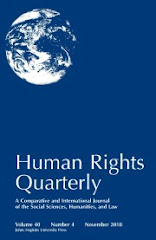The practice of rendition — the involuntary transfer of an individual across borders without recourse to extradition or deportation proceedings — is not new. Indeed, the practice of snatching a defendant for trial — “rendition to justice” — has been used by governments for more than a century. Although rendition has been controversial in human rights circles, it has been celebrated by many as crucial in the fight against impunity for grave crimes. Former U.S. President George W. Bush was criticized for the “novel” practice of “extraordinary rendition” — the transfer of suspects to locations known for the systematic use of torture, including secret CIA prisons (this set of practices is hereinafter referred to as the “Extraordinary Rendition Program”). U.S. officials at the time defended the practice, relying on justifications developed to support “rendition to justice” and arguing that the U.S. Extraordinary Rendition Program was legal. Despite these justifications, international human rights bodies and intergovernmental organizations including the Council of Europe, the European Union, and human rights bodies of the United Nations, determined that the extraordinary form of rendition was unlawful under human rights law.Soon after former President Barack Obama was inaugurated in January 2009, he promised to end the most severe human rights violations carried out by the U.S. government in the name of fighting terrorism, including the use of torture and secret detention facilities. While this move was a positive signal that the United States planned to bring its practice into line with international norms, the Obama Administration in fact retained a number of problematic tools developed by previous Administrations. Although Obama signed executive orders ending the use of torture and secret detention, he did not order the cessation of all informal transfers. Nor did he pursue accountability for those who designed and implemented the Extraordinary Rendition Program. Instead, his Administration continued to quash rendition-related cases with the argument that such cases dangerously threatened to reveal “state secrets.” Although it is impossible to know precisely how many informal transfers were carried out by the Obama administration, the number plainly was significantly smaller than those conducted by the Bush Administration. Instead, President Obama increased the use of drones to target and kill suspected terrorists outside the United States, and continued the use of proxy detention in the name of fighting terrorism.
The Trump Administration presents alarming new risks: in addition to the anti-terrorism tools left in place by the Obama administration, President Trump has promised to use torture and said he would fill Guantánamo Bay with “bad dudes” captured in the fight against al-Qaeda and ISIS. While President Trump’s most disturbing campaign promises have not yet come to fruition, the administration’s lack of transparency surrounding counter-terrorism measures, the on-going U.S. military engagements in Afghanistan, Syria, and Iraq, and the hunt for Al Qaeda in Yemen present opportunities for the U.S. government to return to — or worsen — the abusive practices it pioneered as part of the Extraordinary Rendition Program. With the publication of the National Security Strategy in December 2017, the Trump Administration renewed its commitment to fighting terrorism in aggressive terms with little consideration for human rights.
The threat that counter-terrorism measures will become more abusive is made more stark by the rise in nationalist governments pursuing protectionist policies with weakening regard to human rights guarantees. With governments moving to close borders, deport non-nationals, denaturalize their own citizens, and use informal means to transfer suspects, the mechanisms through which a state may transfer custody of an individual — and the permissible purposes for such handovers — have escaped careful scrutiny. In this era of global realignment, the human rights principles guiding inter-state cooperation in such matters must be reasserted. This chapter examines the legal norms governing informal transfers and detentions in this new era and sets out a minimum standard that must be upheld whenever a state renders an individual, no matter how extraordinary the context.
Thursday, March 15, 2018
Satterthwaite & Zetes: Rendition in Extraordinary Times
Margaret L. Satterthwaite (New York Univ. - Law) & Alexandra Zetes have posted Rendition in Extraordinary Times (in Beyond Human Rights and the War on Terror, forthcoming). Here's the abstract:





